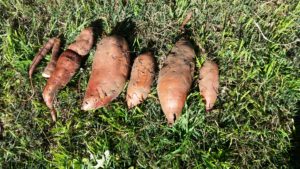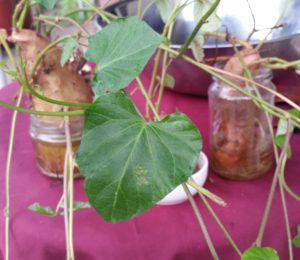Why do the Chinese grow sweet potatoes everywhere?
Because they are versatile and grow rapidly with their vines forming a living ground cover. No need to weed! You can eat the young green tips and the tubers.
Plant sweet potatoes, because they are such a rewarding crop to grow.
Health benefits of eating sweet potatoes
Reasons to eat sweet potatoes include:
- rich source of lutein, one of nature’s anti-cancer remedies. For the entire growing season, you can harvest sweet potato greens (cut only the tips up to three leaves) and add to your smoothie or lightly fry with coconut oil adding garlic at the finish.
- full of Vitamin C, which boosts your immune system and keeps teeth and gums healthy
- rich in complex carbohydrates, dietary fibre and beta carotene
- moderate amounts of micro-nutrients , vitamin B and manganese.
Growing tips

- Harvest before the frost (between two and nine months after planting).
- Plant after the last frost.
- They are sensitive to drought and will rot in water-logged situations.
International culinary uses
- In Uganda, they slice the root and dry it in the sun for amukeke. This is served for breakfast with peanut sauce.
- In Sudan they bake the root under the ground and it is served with tea.
- In West Africa and China the vine tips are eaten as vegetable.
- In Kenya they are mostly eaten mashed. Flour from dried tubers replaces wheat and sugar in baked goods.
- In Egypt they are a common street food- batata. They are baked and served drenched in honey.
- In Ethiopia they are boiled and eaten as a snack.
- In Asia they are served roasted – gungaguma and as a soup – tong sui.
- In Japan they make sweet potato spirit – shochu.
- In Sri Lanka the tubers are boiled or grated and served with curry – bathala.
- In the Maldives the leaves are finely chopped and added to dishes.
- In Malaysia and Singapore the tubers are cut into cubes and cooked with yam and coconut milk to make a sweet desert – bubur caca. The young leaves and tender shoots are eaten as salads with shrimp paste.
- In Indonesia they are fried in batter and served as snacks – ubi jalas
- In New Zealand commonly served as a roasted vegetable – kumara.
Download your PDF of the NatureHealth Companion Planting Guide
“Some people think I look like a sweet potato, I consider myself a spud with a heart of gold”
Shirley MacLaine
